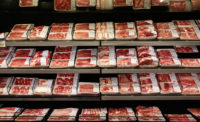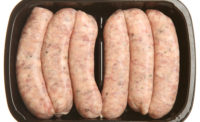I recently spoke with a packaging executive whose fingers are in the tray sealing and the thermoforming markets both abroad and in the U.S. I came away from our conversation with a clear appreciation that, with a few exceptions, thermoformed trays have a place in protein packaging; it’s just not first place.
Despite its eye-catching benefits, thermoforming suffers from an incurable ailment: being second. Tray sealing was and remains first. It works, it adapts to a multitude of production needs and, most important, there is a large installed equipment base. “You don’t see many people changing over to thermoformed because it’s quite an expensive proposition to do so. You could probably pick up a couple of tray sealers for the price of a thermoforming machine,” says the executive.
There don’t appear to be many cracks in the armor. “A medium-sized producer can get into tray sealing, with a number of different sizes on one machine, quite easily and cheaply.” That kind of flexibility and affordability falls right into the sweet spot of a contemporary marketplace needing a greater assortment of pack sizes to satisfy the whims of 21st Century family dynamics. “You’ve got your single person, married couple and family who all want to buy steak, let’s say, but it requires three or four tray sizes to satisfy those market segments. With a tray sealer, switching tooling takes about five minutes, and maybe an hour or two with a thermoformer.”
By this measure, thermoforming comes across as being fixed. But if you have the volume, you can certainly thermoform quite easily. Turn on the line and let it rip. It goes back to production flow. Some processors may pack separately from where they seal the trays. It depends on the plant and the process. “With a tray sealer, you can still have automatic loading and such to accommodate. I think it’s just more flexible.”
In fairness, there are some real benefits with thermoforming systems. You can reduce storage space for packaging materials. “It’s decreased by a ratio of seven to one when you’re thermoforming compared to pre-made trays.” The contrast in tray costs is also attention-grabbing. “Thermoform trays can be as much as 30 percent to 50 percent less. If you have the volume on one particular tray size you could see some advantage.” He also expressed a point I have not considered. “In most markets you may have a choice of five tray suppliers. By going to a thermoformed tray, it opens your supplier base to 15 to 20 film manufacturers. You can leverage your purchasing power by shopping around for films and playing with different structures.”
These are serious points worth serious reflection, but I go back to my opening statement. Things that work, and work well, are almost impossible to replace, especially when the switching costs are high and potentially disruptive. “You don’t want to spend money on equipment without a firm commitment from your customers. They may want to stick with the package that supports the largest margin.” It appears that a truly expansive future for thermoforming rests with less expensive and more versatile equipment, according to the executive.
Tray sealing’s grip on the meat case remains secure and is likely to continue because there is no substitute for being first — and good. NP




